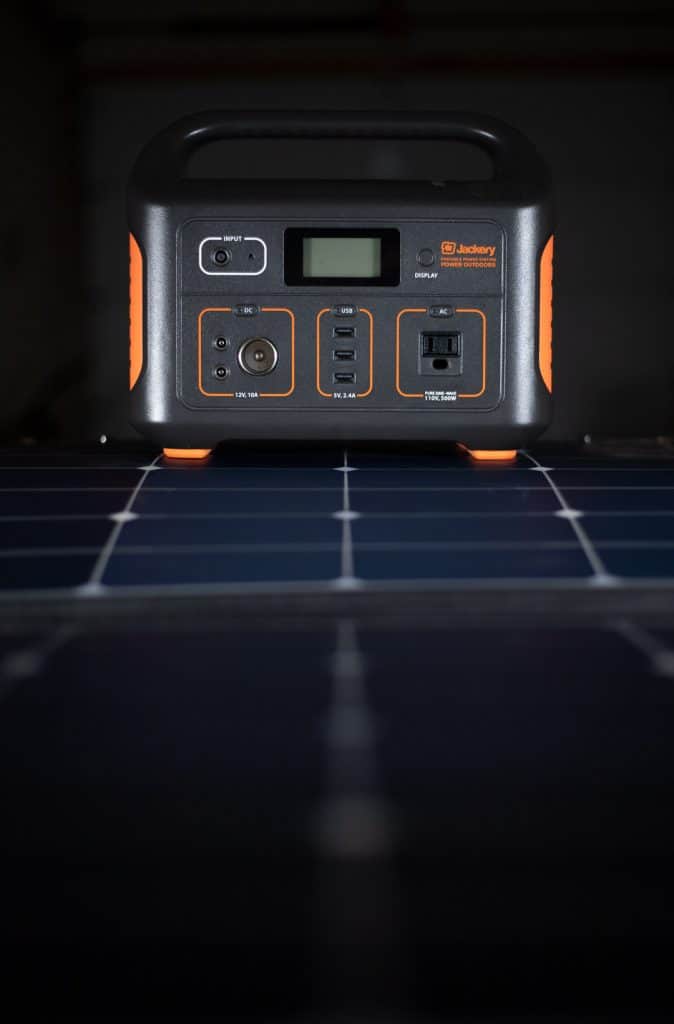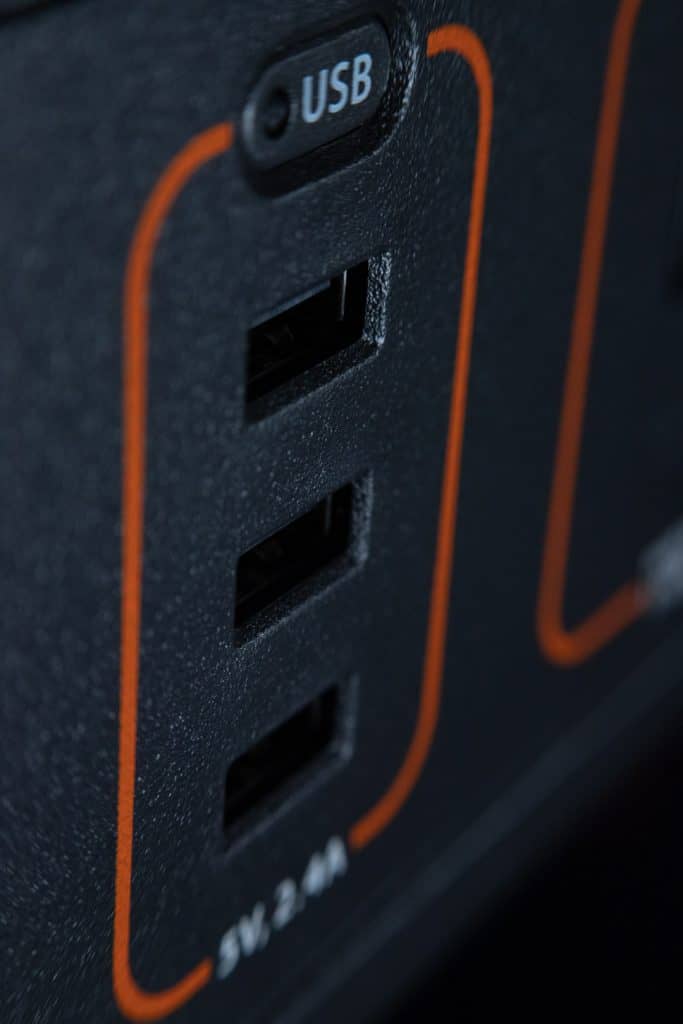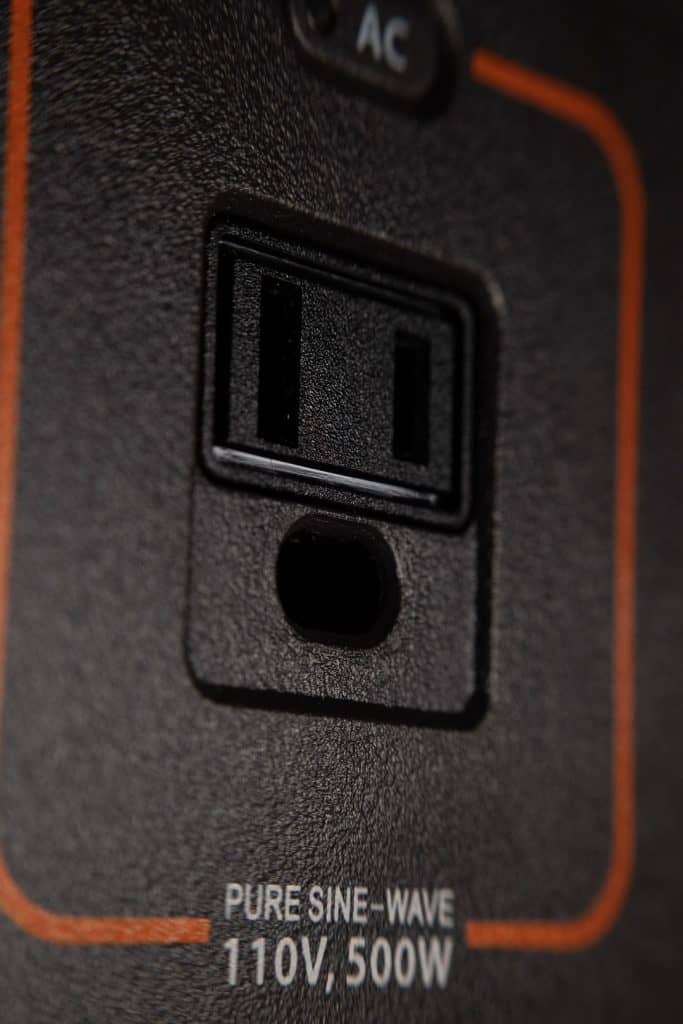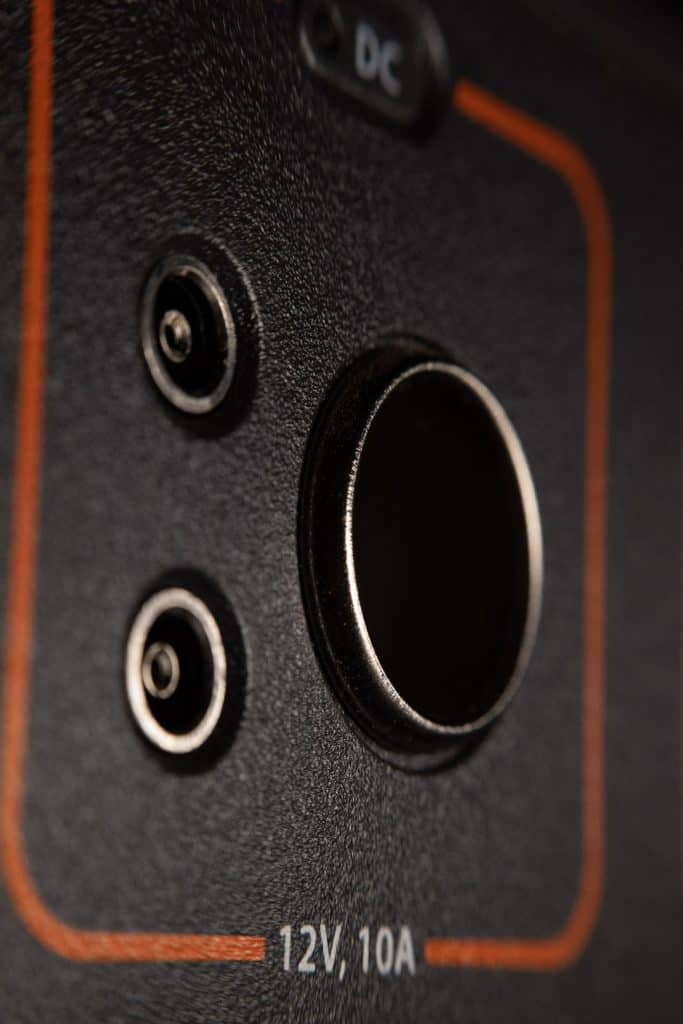
The Jackery Explorer 500 is a new portable power station aimed at providing a modest amount of portable power wherever you need it. In this blog post, I’m going to cover some of the main features, capacities, ways to recharge the unit, and what you can expect to be able to power with this unit and if it’ll be a good choice for your needs. Let’s get started:
Disclaimer: This is a sponsored post. More info.
What is a Portable Power Station?
A portable power station is an all-in-one power unit designed for use as a way to bring enough power with you to run computers, charge phones, drones and run other small devices.

It typically is a battery, inverter, and solar charge controller all in one self-contained box with power outlets of various types on the outside. Now, let’s talk about what kind of items this unit can power:
What can the Jackery Explorer 500 power?
Jackery Explorer 500 USB Outlets
The Explorer 500 comes with three, 2.4A USB outlets; so it will charge any of your standard USB devices.

Jackery Explorer 500 120V Inverter
Inside of the Explorer 500 is a 500W pure sine-wave inverter capable of handling 1000w power surges.

This means that the Explorer 500 is capable of handling up to 500w of continuous power with some wiggle room for items that take more power, momentarily, to start.
Here is a quick list of common items that are under 500W that the Jackery would be able to power:
- Laptops and most desktop computers
- CPAP Machine
- Small Refrigerator
- Fans
- Playstation/xbox
- Television
- Desk Lamp
Some items that are going to require too much power for the Jackery Explorer 500 are going to be:
- Toaster Oven
- Blender
- Air Conditioner
- Space heaters
- Electric hot water heaters
- Residential sized refrigerators
If you’re not sure if the devices you are wanting to power will work with the Explorer 500, there is typically a plate on the device that will tell you the wattage; so as long as it’s under 500w, you’re good to go.
Ultimately, though, the Explorer 500 has internal breakers that will trip if you try to power something that requires too much power for what the Explorer 500 can provide.
Jackery Explorer 500 12v Outlets
The Jackery Explorer 500 has 3, 12v outlets. One is a cigarette lighter style of outlet and is capable of handling 10 amps and the other two are 6mm outlets capable of handling a combined 7 volts.

All three CAN be used at the same time, but 10 amps is the maximum power output between all of the 12v outlets combined.
If you were attempting to run 12v appliances like lights and fans off of this unit, you could wire some 10ga duplex wire to a cigarette lighter male pigtail. The other end would go to a small fuse block. From there, you could hardwire some led puck lights or even a maxxair roof fan.
Jackery Explorer 500 Battery Capacity.
The Jackery Explorer 500 has a 518 Watt Hour lithium nickel manganese cobalt oxide battery. (It’s just a lithium battery…) This is the same chemistry of battery that Tesla uses in their powerwall units.
Since most of you are looking for this info in regards to camper van setups, a 518 Watt Hour lithium battery is effectively 41 amp hours at 12.6v.
The battery has a stated life of only 500 cycles; BUT… they state that the ‘life’ of the battery is to 80%. So… if you completely drain, then recharge the battery every single day, after a year and a half, you’ll still have 32ish amp hours of battery capacity left in the unit that you’ll still be able to use. So, actually, pretty good in my opinion. Especially considering you’ll likely not send it through a complete cycle each and every day.
Recharging the Jackery Explorer 500
The Jackery Explorer 500 can be recharged in 3 different ways. 120v standard household outlet, car charger, or solar. Input is limited to 3.5 amps of DC current but will charge at two different wattages depending on how many volts are pushing those amps
Charging by 120v Wall Outlet
Charging by your standard household 120v wall outlet will be the fastest way to charge. Plug it in and it will charge at a little over 80 watts. It can charge at 80 watts because the AC/DC adapter is pushing those 3.5 amps at about 25 volts. This will allow the unit to charge from 0 – 100 percent in about 7.5 hours.
Charging by 12v Car Adapter
Charging by the 12v Car Adapter will charge at about 45 watts. It charges at 45 watts because when 12v power is limited to 3.5 amps, the maximum amount of wattage available to charge with is 45 watts. This will allow the unit to charge from 0 – 100 percent in about 11.5 hours.
Charging by Solar Panel
Using the portable, suitcase-style Jackery SolarSaga 100W solar panel, the Explorer 500 will charge at a max rate of about 65 watts (depending on cloud cover and sun angle, of course).
It charges at 65 watts because when this panel is performing optimally, it’s operating at 18 volts. When 18v power is limited to 3.5 amps, the maximum amount of wattage available to charge with is about 65 watts.
According to the user manual, the Explorer 500 will charge from 100W of solar panels in 16 Hours (depending on weather), but I have a pretty strong feeling (and a bit of math on my side) that tells me that as long as full sun is available, and you keep the solar panels angled toward the sun, the unit will charge from 0 – 100 percent closer to the 9 hour ballpark.
Charging with Non-Jackery Solar Panels
If you don’t need the added portability of the Jackery SolarSaga Solar Panel, or, say, want to mount a rigid panel to your campervan roof, but STILL want the portability benefits of the EXPLORER 500, it’s totally possible to charge the Explorer 500 with other solar panels. You’ll just need an MC4 to Anderson Connector Adapter and a compatible solar panel. Here’s a link to that adapter: https://amzn.to/2StNyt7
(PLEASE verify polarity of the wires (which one is positive and which one is negative) before connecting)
To find a compatible non-jackery solar panel, you’ll simply be looking for a panel that has similar specs as the Jackery SolarSaga. For the Solar Saga 100w panel, it has THESE stats.
- Rated Power: 100 watts
- Power Voltage: 18V
- Power Current: 5.5A
- Open Circuit Voltage: 21.6V
- Short Circuit Voltage: 6A
So, you’ll just be looking for an alternative panel with specs similar to those. Here are a few suitable alternatives:
ALTERNATIVE PANELS:
- MYAH 100W: https://amzn.to/32H5F3G
- Renogy 100W: https://amzn.to/2Yj54pn
- Newpowa 100W: https://amzn.to/2XVvUV4
IS THE JACKERY EXPLORER 500 FOR YOU?
All in all, I REALLY like the Explorer 500. I really like the fact that there is only 1 input charging port for no matter which power input you plan on using. I like the inverter is a pure sine wave inverter. I like that all of the cables to get up and running are included. I REALLY like the fact that if you couple this with the SolarSaga panel, it’s truly as plug and play as you can get.
When I unboxed this for the first time off-camera, I’ll admit, I didn’t read any directions, but was able to get it up and running within about 10 seconds. It’s very straightforward.
Having 40Ah of useable battery capacity, a charge controller, an inverter, and plugs in a unit that is about the same size as a 12 pack of delicious summer shandy, is honestly pretty impressive.
Now, that’s all of the positives. How about some negatives?
Truly, I don’t have any negatives about the unit. There is a flashlight on the side, which is a little cheesy in my opinion, but whatever… I suppose if you lose your headlamp, there’s a much better chance of being able to find this thing, click on the light, and look for your actually useful headlamp. But nobody is buying this as a flashlight; let’s be honest.
But this Explorer 500 isn’t for everybody. Like with anything else in the mobile electric world, there are very few one-size-fits-all items. Here are a few things to consider that might mean that the Explorer 500 is NOT a good fit for your needs:
- If you need to power items that are more powerful than the 500W inverter can handle, you’ll likely be unhappy with the performance of this unit.
- If you want your system to be expandable in the future; this Explorer 500 is unable to expand to handle bigger power demands or faster charging from more solar.
- If you plan on regularly using more than 30-35 amp hours per day, you may be unhappy with this unit.
- For example, this unit would never work for Steph and me on our normal workdays. Between the coffee maker, 4g booster, wifi hotspot, lights, fans and 2 high powered laptops, we historically use about 300 Amp Hours of battery capacity during our normal work day on the road. It would be unreasonable to suggest that this unit would work for our high energy demands.
If you aren’t trying to regularly work from the road, putting in those 12 hour days on a laptop and you don’t need near-unlimited power available to you through an expandable, multi-thousand dollar DIY setup. I could REALLY see this as being a great fit.
Ultimately though, I HIGHLY recommend running a power audit to find out how much power you can anticipate using on a day to day basis. Here’s a walkthrough for that: https://www.explorist.life/what-size-of-solar-system-is-needed-to-power-a-camper/
Thanks for taking the time to check out this blog post and if you’ve got any questions for me; leave them in the comments below and I’ll answer them as soon as I can.
Here are a few more links you may find helpful:
?This product launches and will be available for purchase on Monday, July 22nd 2019
? Jackery Explorer 500 on Amazon: https://amzn.to/32E3DB7
? Jackery Solar Saga 100W Solar Panel: https://amzn.to/32zrCBH
? Youtube video for the Jackery Explorer 500: https://youtu.be/sp7ObNA97QM
? Official Product Pages:
▪ Jackery Home Page: https://www.jackery.com
▪ Jackery Explorer 500: https://www.jackery.com/products/explorer-500w-portable-power-station
▪Solar Saga 100W Solar Panel: https://www.jackery.com/products/solarsaga-100w-solar-panel
▪ Jackery Explorer 500: https://www.jackery.com/products/explorer-500w-portable-power-station
▪Solar Saga 100W Solar Panel: https://www.jackery.com/products/solarsaga-100w-solar-panel
DISCLAIMER
THIS HAS BEEN A SPONSORED POST. I have been compensated to write this blog post and teach you about this product. All thoughts and opinions are my own.

15 Responses
Nate ~
Thanks for that really nice review review. I especially like your recommendation to “run a power audit.” However, based on a coupla comments/questions posted here, and the torrent of them in the FB Jackery Piwer Users group, it seems some folks get intimidated by (or never learned) simple third grade math – like multiplication and division. Or, they’re just plain lazy. “Can my Jackery (no size identified) power my coffee maker (no wattage or current demand identified).
Nonetheless, keep up the good work!
Jules
(Two Jackery 500s and a Rockpals 100W foldable, since July 2019)
Hey Nate.
Thinking about the Inergy FLEX 1500 POWER STATION coming in February versus a custom system. You can add expansion batteries to it which seems handy. Do you design wiring diagrams for this sort of set up where I could use the power station all in one unit that then connects to the more permanent inside wiring (lights, 110 outlets, etc). Or maybe I have one battle born that does the more permanent inside stuff and I also have a stand alone unit. I have several questions, but might be better to take offline if you do that sort of thing.
Thanks. Morgan
I am currently not offering custom wiring diagrams and I do not have one incorporating that unit publicly available. Sorry about that!
You mention wiring this to a fuse box. I’m curious if you see any significant disadvantage or hazard to wiring a small fuse box to a male cigarette adapter and using this Jackery 500 (or the larger 1000) to run some minimal equipment in a van such as fan, cooler and puck lights?
It may not run all of that stuff as it has only a 10A output, but you can definitely give it a shot and see what It can actually do. 🙂
My jackery 500 is connected to a 175 watt flexible solor panel. Will this hurt anything.?
What is the max charging rate of the Jackery by the DC charging input? This information is in your user manual.
I have had my Jackery 2 weeks and a Jackery Solar Panel, i have been trying to Register my products on line with them and i get rejected everytime, i have E-Mailed them , called them and left a message, all i get back is how to go on line and do the same thing i did before , i am fed up with them , do you have any ideas what to do . Thanks
Darn! I’m not sure, though. I don’t have any insider contact at Jackery.
Great post. I have the Jackery 500 continuously plugged into my 4runner DC outlet. Do I need a stronger car battery?
If your car battery keeps dying, yes. Otherwise, no.
Hi Nate–Have a question regarding charging the Jackery 500. I have 2 100 watt solar panels and a battleborn 100ah battery. The battery is charged with the panels as well as an isolator/alternator/car battery. Attached to the battery is my fuse box which has a cig light outlet as well as usb ports. I do not have an inverter or AC power. Can I charge the Jackery with my cig lighter which is attached to the fuse box as apposed to lighter in the van? If so what fuse size would you suggest it be attached to? Thank you so much!!!
Yes, you should be able to charge the Jackery in that method. Fuse size will depend on wire size. How to size fuses: https://www.youtube.com/watch?v=5y-yDMEgV70
Thank you for the article. I am new to solar in general. In the article you mention an adapter MC4 to Anderson Connector Adapter is that correct I see the Jackery is suppose to have an 8mm input? And I just want to make sure I get the proper connector for the one of the alternative panels you mention.
Oops! Yes; you’re correct. You’ll want MC4 to 8mm.